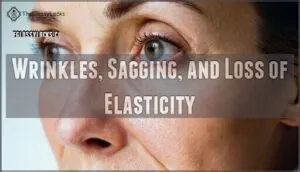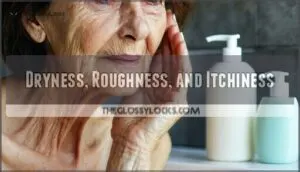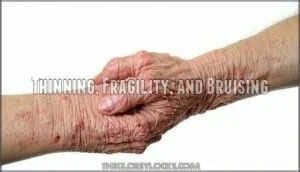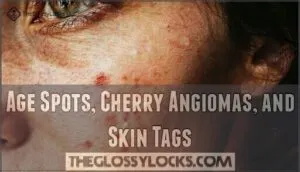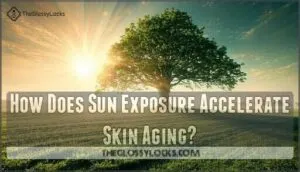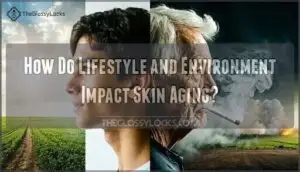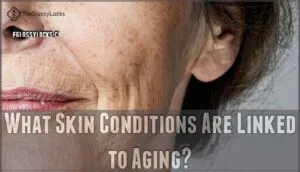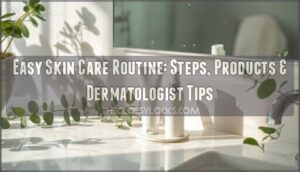This site is supported by our readers. We may earn a commission, at no cost to you, if you purchase through links.
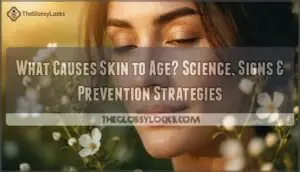
But what catches many off guard is that the visible aging on your face has been quietly building for years, accumulating damage at the cellular level long before any wrinkle appeared. The real culprits behind skin aging aren’t mysterious—they’re a mix of your internal biological clock (intrinsic aging) and external factors like UV radiation, pollution, and lifestyle choices (extrinsic aging).
While you can’t stop time, understanding what breaks down collagen, triggers oxidative stress, and speeds up cellular damage puts you in control. The difference between skin that ages gracefully and skin that shows premature wear often comes down to recognizing these mechanisms and knowing which protective measures actually work.
Table Of Contents
- Key Takeaways
- What Causes Skin to Age?
- What Are The Visible Signs of Aging Skin?
- How Does Sun Exposure Accelerate Skin Aging?
- How Do Lifestyle and Environment Impact Skin Aging?
- What Skin Conditions Are Linked to Aging?
- How Can You Prevent and Manage Skin Aging?
- Frequently Asked Questions (FAQs)
- What happens to your skin as you age?
- Is your skin aging prematurely?
- Why does my skin look older?
- What causes skin aging?
- What is skin aging?
- What causes skin aging & age spots?
- Can retinol or vitamin C reverse skin aging?
- How does sleep quality affect skin aging process?
- Can facial exercises reduce wrinkles and sagging skin?
- What role do antioxidants play in preventing aging?
- Conclusion
Key Takeaways
- Skin aging results from two distinct mechanisms: intrinsic aging driven by genetics and hormones (particularly estrogen decline during menopause), and extrinsic aging accelerated by UV radiation, pollution, and smoking—with UV exposure alone accounting for over 90% of skin cancers and causing collagen breakdown faster than natural aging.
- The visible signs of aging stem from molecular pathways including overactive mTOR signaling, oxidative stress from free radicals, and cellular senescence that triggers chronic inflammation (inflammaging), all of which degrade the structural proteins that keep skin firm and resilient.
- Sun protection with broad-spectrum SPF 30+ applied every two hours remains your most effective defense against premature aging, while lifestyle factors like smoking and chronic stress actively undermine skin health by depleting collagen, generating inflammatory signals, and impairing your skin’s natural repair mechanisms.
- Early detection through monthly self-checks and annual dermatological exams catches concerning changes before they progress, while evidence-based treatments like retinoids and vitamin C can partially reverse aging signs by boosting collagen production—though no intervention can completely stop the biological clock.
What Causes Skin to Age?
Your skin ages in two main ways: natural changes over time, and damage from environmental factors you can control.
Knowing what drives these processes—from your genes to cell signals—helps you make smart choices about protection and prevention.
Intrinsic Vs. Extrinsic Aging
Your skin changes naturally as you age—that’s intrinsic aging, driven by your genetics. Extrinsic aging, however, accelerates this process through UV exposure, pollution, and lifestyle factors you can actually influence.
Intrinsic aging is like a timer you can’t reset, while extrinsic damage piles on preventable wear and tear.
Key differences include:
- Intrinsic aging affects all your skin evenly, even protected areas
- Extrinsic aging targets sun-exposed areas like your face and hands
- Cellular damage from UV light breaks down collagen faster than aging alone
- Skin degradation happens faster when both aging mechanisms are at play
Role of Genetics and Hormones
Your genetics determine how your skin ages, but hormones—especially during menopause—can dramatically speed up that process by making your skin drier and thinner. Estrogen levels drop sharply during this phase, reducing collagen production and weakening your skin’s natural barrier.
| Factor | Mechanism | Visible Impact |
|---|---|---|
| Genetic predisposition | Controls baseline aging rate | Wrinkle depth, texture |
| Estrogen decline | Reduces collagen synthesis | Thinning, dryness |
| Menopause effects | Alters skin homeostasis | Fragility, sagging |
| Hormone therapy | May restore moisture balance | Improved elasticity |
Key Molecular Pathways (e.g., MTOR, Oxidative Stress)
Your skin ages through more than just genetics and hormones—specific molecular pathways drive the process at a cellular level. Three mechanisms stand out:
- mTOR signaling becomes overactive with age, disrupting protein balance and accelerating tissue degeneration—inhibiting this pathway in animal models improved skin aging biomarkers by 20%.
- Oxidative stress floods cells with reactive oxygen species that damage DNA, proteins, and lipids, breaking down collagen while ramping up wrinkle-forming enzymes.
- Cellular senescence causes damaged cells to accumulate and release inflammatory signals, creating a chronic state called inflammaging that undermines skin health and repair.
Understanding the role of oxidative stress factors is key in addressing skin aging. These interconnected pathways explain why aging skin loses resilience and develops visible damage over time.
What Are The Visible Signs of Aging Skin?
As you age, your skin tells the story. The changes start subtle but grow harder to miss.
Understanding what’s happening—and recognizing the telltale signs—helps you know what to expect.
Wrinkles, Sagging, and Loss of Elasticity
One of the most recognizable signs of aging is the gradual appearance of wrinkles, sagging skin, and a noticeable loss of elasticity—all caused by the breakdown of collagen and elastin fibers that once kept your skin firm and resilient. As these structural proteins degrade, your skin loses its ability to bounce back after stretching or facial expressions, leading to permanent creases and drooping contours.
| Aging Change | What You’ll Notice |
|---|---|
| Collagen decline | Fine lines deepen into wrinkles, especially around eyes and mouth |
| Elastin breakdown | Skin sags and loses bounce-back ability |
| Combined loss | Jowls form, cheeks hollow, facial firmness fades |
It’s like watching a worn-out mattress lose its support—once the springs give way, the whole thing sinks in on itself.
Dryness, Roughness, and Itchiness
As we age, our skin often loses its ability to retain moisture, leading to dryness, roughness, and persistent itching. This happens because the skin’s protective barrier weakens, allowing moisture to escape more quickly while producing less natural oil to lock it in.
The result is flaky patches, a tight feeling after washing, and an urge to scratch that can worsen irritation and harm skin health if ignored.
Thinning, Fragility, and Bruising
As the years go by, your skin naturally thins and becomes more fragile. What was once a minor bump can now leave a bruise that sticks around for days.
This happens because the layers of your skin – the epidermis and dermis – lose volume, and the connection between them flattens, reducing the skin’s natural padding. Collagen loss also weakens blood vessel walls, making them more likely to break under pressure.
You might notice that skin tears more easily and wounds take longer to heal than they used to.
Age Spots, Cherry Angiomas, and Skin Tags
As you get older, you’ll notice new spots and bumps showing up on your skin.
Age spots, or liver spots, are flat, dark patches that show up in areas with the most sun exposure. Cherry angiomas appear as tiny red dots, usually harmless and common after age 30. Skin tags are soft, hanging flaps that often form where skin rubs together.
While these benign growths rarely need treatment, regular check-ups with a dermatologist help ensure they’re not something more serious.
How Does Sun Exposure Accelerate Skin Aging?
The sun’s UV rays do more than tan your skin—they damage the structure that keeps it firm and elastic.
UV exposure accelerates aging, triggers abnormal skin growths, and raises your cancer risk.
Effects of UV Radiation (Photoaging)
UV radiation slowly damages your skin, breaking down the proteins that keep it firm, smooth, and youthful. Over time, this leads to wrinkles, sagging, and a leathery texture known as photoaging.
Sun damage also causes uneven skin tone and increases the risk of skin cancer, making premature aging just one of many consequences of long-term sun exposure.
Actinic and Seborrheic Keratoses
Too much sun doesn’t just cause wrinkles—it can also lead to rough, scaly patches called actinic keratoses and flat, tan growths known as seborrheic keratoses.
Actinic keratoses are precancerous skin lesions that need a dermatologist’s attention, as they can turn into skin cancer if untreated.
Seborrheic keratoses, however, are harmless growths that look like age spots and don’t pose health risks, though some people may choose to remove them for cosmetic reasons.
Sun Damage and Skin Cancer Risk
Sun damage goes deeper than fine lines and age spots. UV radiation causes over 90% of skin cancers by damaging DNA and triggering cell mutations. Protect yourself with:
- Apply broad-spectrum sunscreen with SPF 30 or higher every two hours
- Seek shade during peak UV hours (10 a.m. to 4 p.m.)
- Schedule regular dermatological screening for early detection
Understanding skin cancer prevention is key for protecting your skin.
Here’s something to keep in mind: a single bad sunburn during your teens or twenties can raise your melanoma risk by as much as 80%.
That’s why protecting your skin from sun damage isn’t just about preventing wrinkles—it’s about preventing cancer too.
How Do Lifestyle and Environment Impact Skin Aging?
Your lifestyle and surroundings do more than sun exposure alone—they shape how early aging shows up on your skin. Smoking, pollution, what you eat, how much water you drink, your activity level, and chronic stress all play a role.
Effects of Smoking and Air Pollution
Smoking and air pollution deliver a powerful one-two punch that speeds up aging beyond what sun exposure alone can do. Tobacco smoke triggers oxidative stress and ramps up enzymes that break down collagen and elastin, leaving you with deeper wrinkles and sagging skin. Meanwhile, particulate matter from traffic and industrial sources settles on your skin, generating free radicals that damage DNA and proteins.
Studies show smokers with over 40 pack-years develop much more pronounced wrinkling, while chronic exposure to PM2.5 increases pigment spots by roughly 12.5% per pollution increment. Both toxic exposures disrupt your skin’s repair mechanisms and thin the protective barrier, making premature skin aging and other skin health issues far more likely.
| Exposure Type | Primary Mechanism | Visible Outcome |
|---|---|---|
| Cigarette Smoke | Upregulates MMPs, depletes collagen | Deep wrinkles, sagging |
| PM2.5 Particles | Generates ROS, triggers inflammation | Pigment spots, coarse texture |
| Traffic Pollution | Impairs barrier function, oxidative damage | Irregular pigmentation, sensitivity |
| Ozone | Reduces antioxidants, mitochondrial stress | Dullness, fine lines |
| Indoor Pollutants | Chronic low-level oxidative injury | Barrier dysfunction, irritation |
Complete avoidance isn’t realistic, but cutting out cigarettes and staying clear of heavily trafficked roads lets your skin start repairing damage and slows down how quickly it ages.
Diet, Hydration, and Exercise
What you put into your body is just as important as what you keep out. Eating balanced meals packed with antioxidants, omega-3s, and vitamins helps boost collagen production. Staying properly hydrated keeps your skin looking plump and healthy.
Regular exercise improves circulation, delivering nutrients that promote a youthful appearance and strengthen your skin’s natural defenses, working hand-in-hand with a good skincare routine.
Stress and Its Role in Skin Health
You might eat well and stay active, but chronic stress still sabotages your skin from the inside out—speeding up aging in ways that aren’t always obvious.
Stress management matters because it:
- Reduces skin inflammation that triggers breakouts and irritation
- Balances hormones that regulate oil production and cell turnover
- Boosts emotional wellness, preventing stress-related skin conditions
- Improves sleep quality, when your skin repairs itself
- Boosts your mindful skincare routine’s effectiveness
If you want healthy, resilient skin as you age, stress management has to be part of the plan—not something you add when you have time.
What Skin Conditions Are Linked to Aging?
As skin ages, it becomes more prone to certain conditions that can impact both appearance and comfort.
Three issues often show up: varicose and spider veins, persistent dryness and itching, and bacterial infections that can cause ulcers.
Varicose and Spider Veins
As we age, our skin’s blood vessels can weaken, leading to swelling, twisting, and bulging. These changes often appear as varicose or spider veins on the legs and feet.
While they might seem like just a cosmetic issue, these veins can indicate deeper problems with blood flow and, in some cases, link to inflamed veins or superficial blood clots.
Compression stockings are a helpful solution, as they improve circulation, reduce swelling, and support overall skin and vein health.
Chronic Dryness and Itchiness
Dry, itchy skin might seem like a minor annoyance, but persistent scratching can point to something more serious—think kidney disease or thyroid issues.
Here’s how to fight back against dryness and calm that itch:
- Drink plenty of water to keep your skin hydrated from the inside out
- Apply moisturizer right after bathing to seal in moisture
- Choose gentle, fragrance-free cleansers to avoid stripping natural oils
- Use a humidifier during dry seasons to keep your skin healthy
If these remedies don’t work or your skin gets worse, see a dermatologist to check for underlying conditions affecting your skin’s health and aging.
Bacterial Infections and Ulcers
As we age, our bodies become more vulnerable to bacterial infections and ulcers. Skin problems are especially common, affecting about 32% of adults over 65. Conditions like diabetes, poor circulation, and being bedridden greatly increase the risk of infections and make it harder for ulcers to heal. Weakened skin and slow healing create an environment where bacteria can easily enter damaged tissue. This is a big concern in nursing homes, where nearly 79% of residents don’t get enough proper nutrition.
| Risk Factor | Impact on Skin Health Issues |
|---|---|
| Diabetes | 4× higher infection risk; impaired wound healing |
| Immobility | 12%+ develop pressure ulcers; tissue breakdown accelerates |
| Malnutrition | Weakened skin barrier; 79% of nursing home residents affected |
| Incontinence | 85% of ulcer patients; moisture damages aging skin symptoms |
To fight these age-related skin problems, focus on protecting your skin from injury and eating a healthy diet. Regular check-ups can help catch skin issues early, preventing them from becoming serious health problems.
How Can You Prevent and Manage Skin Aging?
There are real ways to slow aging and maintain healthier skin. Prevention matters, your daily routine matters, and sometimes you need expert guidance.
Sun Protection and Skincare Routines
You don’t need expensive products to fight aging skin—just steady, proven sun protection and a solid routine. What makes the difference:
- Sunscreen Application: Use broad-spectrum SPF 30 or higher every day, even when it’s cloudy, to prevent sun damage and premature aging.
- Daily Moisturizing: Keep your skin hydrated to fight dryness and strengthen its natural barrier.
- Skin Exfoliation: Gently remove dead skin cells to improve texture and make your nighttime products more effective.
Healthy Lifestyle Choices
Your skin doesn’t age in a vacuum—what you eat, how much you move, and whether you smoke all play a direct role in how quickly (or slowly) aging shows up.
Eating plenty of fruits and veggies nourishes your skin from the inside, while regular exercise improves circulation and delivers oxygen to your cells.
Don’t forget to stay hydrated, manage stress through mindfulness or hobbies, and prioritize quality sleep—your skin repairs itself overnight, making rest key to preventing aging.
Early Detection and Dermatological Care
Catching skin changes early—before a harmless spot turns into something serious—can make all the difference in how you age. Schedule regular dermatologist visits to monitor changes, especially if you’ve had significant sun exposure or notice new growths.
Your dermatological care checklist:
- Monthly self-checks – examine your skin for new spots, changing moles, or unusual textures
- Annual professional skin exams – let your dermatologist catch what you might miss
- Early intervention – address suspicious lesions before they progress to cancer
- Cosmetic treatments – discuss retinoids, chemical peels, or laser therapy to reverse damage
- Preventive measures – combine sun protection with targeted skincare for lasting results
Frequently Asked Questions (FAQs)
What happens to your skin as you age?
Think of your skin like a favorite leather jacket that’s seen better days. Over the years, collagen breaks down and the outer layer gets thinner.
The result? Skin that’s more delicate, less springy, and clearly showing its age.
Skin cells renew more slowly, leading to dryness, sagging, and easier bruising. This happens due to both internal and external factors.
Is your skin aging prematurely?
Watch for signs like ongoing dryness, fine lines showing up sooner than they should, patchy skin tone, or that rough, uneven feel.
Premature skin aging is often caused by photoaging and preventable factors like UV exposure, smoking, and pollution. Simple prevention tips focused on skincare and sun protection can really slow down the aging process.
Why does my skin look older?
Noticed deeper fine lines compared to last year? Several factors speed up aging. Sun damage causes photoaging, while pollution and smoking worsen skin texture.
Less collagen, hormone changes, and oxidative stress also lead to early aging and common skin issues.
What causes skin aging?
Aging happens through a combination of what’s going on inside our bodies—think genetics and cellular wear and tear—and what we’re exposed to on the outside, like environmental toxins and UV rays.
When internal and external pressures team up, they can fast-track skin aging. This shows us how our biology and environment work together to affect how our skin holds up over time.
What is skin aging?
Getting older means your body starts showing signs of breakdown—kind of like how a cassette tape eventually wears out from too many plays.
Skin aging happens when skin cells, tissue structure, and the molecules that keep skin firm and elastic begin to break down. This process leads to noticeable changes in skin texture, tone, and flexibility.
What causes skin aging & age spots?
Your skin ages through a mix of what’s happening inside your body—think genetics and shifting hormones—and what it faces from the outside, like UV rays, cigarette smoke, and environmental pollutants.
Age spots appear when melanocytes overproduce pigment after years of sun damage, leading to cellular harm and changes in your skin.
Can retinol or vitamin C reverse skin aging?
Jennifer, a 52-year-old patient, noticed her fine lines softening after three months of using retinol consistently. She wondered, though, if she’d actually turned back time or just hit pause on aging.
Research shows that topical retinol and vitamin C serum can partly reverse both chronological and sun-related skin changes, boosting collagen production and skin renewal through distinct but complementary processes.
How does sleep quality affect skin aging process?
Lack of sleep throws off your body’s natural rhythm and messes with melatonin levels, which are key for skin repair at night when collagen production is at its peak.
Over time, not getting enough sleep speeds up skin aging, making it less elastic and worsening collagen loss due to increased stress and inflammation.
Can facial exercises reduce wrinkles and sagging skin?
While popular, Facial Yoga and anti-aging exercises have limited scientific backing. Some research suggests consistent facial massage and muscle relaxation may slightly improve skin firmness, but wrinkles result from collagen loss, not just sagging muscles.
This makes skincare and sun protection more effective for maintaining skin elasticity.
What role do antioxidants play in preventing aging?
Antioxidants work by neutralizing free radicals—those unstable molecules that cause oxidative stress and accelerate damage to your skin cells.
These anti-aging compounds boost cellular protection, helping maintain skin health and reduce visible signs of aging when paired with proper skincare routines.
Conclusion
How your skin ages depends on genetics and lifestyle choices working together—not fate alone.
Understanding the factors behind aging skin puts you in control of protecting and preserving its health.
Your genes and the clock matter, sure—but what you do every day matters more.
Sun protection, how you live, your skincare routine: these shape how your skin holds up over time.
The best time to start? Right now.
Make sunscreen part of your morning routine, eat foods that actually fuel your skin, and get a dermatologist on your team who can spot problems before they become bigger ones.
- https://pmc.ncbi.nlm.nih.gov/articles/PMC10206231/
- https://www.frontiersin.org/journals/genetics/articles/10.3389/fgene.2022.836581/full
- https://www.sciencedirect.com/science/article/pii/S2950198925000613
- https://www.medicalnewstoday.com/articles/sunlight-aging
- https://www.nature.com/articles/s41598-022-17443-1

